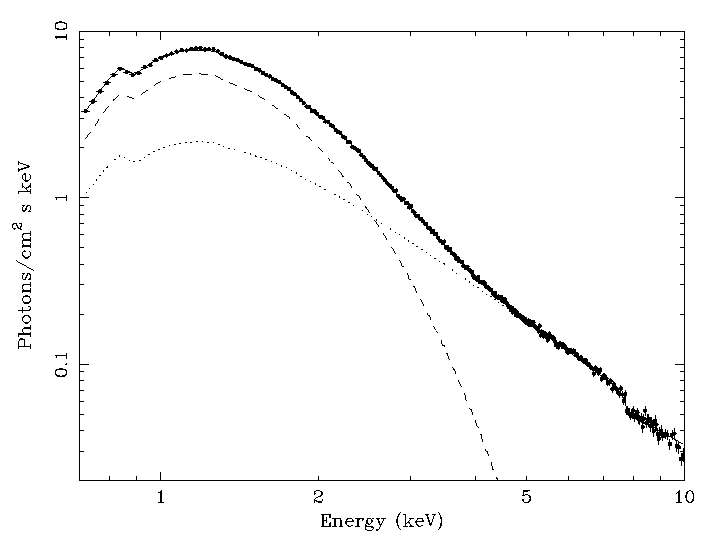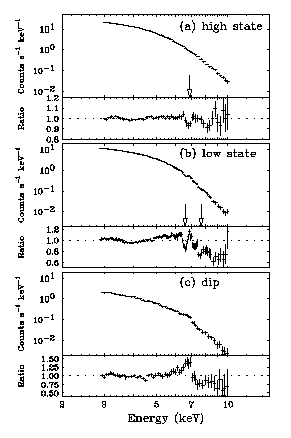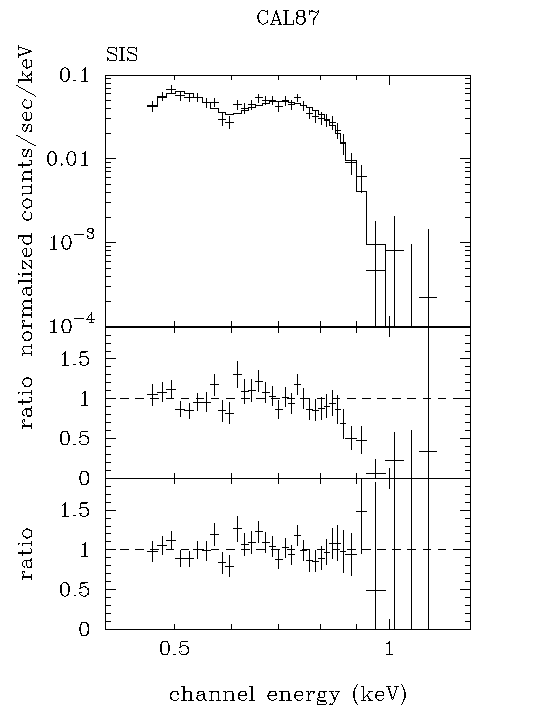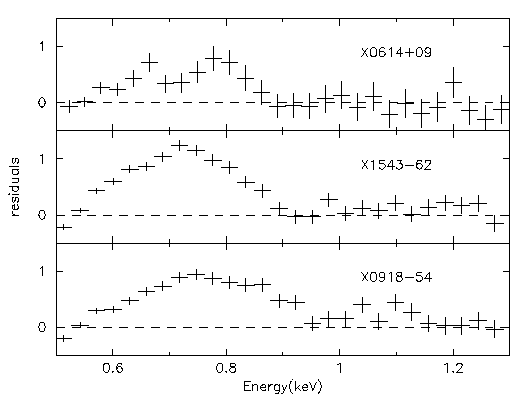X-ray Binaries
Determination of the black hole mass in Cyg X-1
Cyg X-1, as well as other black hole candidates, exhibit two distinct luminosity/spectral states, the hard-low state and the soft-high state, depending on the 2-10 keV luminosity. The soft X-ray spectrum in the soft-high state is considered to originate from an optically thick accretion disk around the black hole. By measuring the accretion disk spectra in the soft X-ray band, the accretion disk parameters, in particular the mass of the central object, may be estimated. Cyg X-1 is in the low-hard state most of the time. In May 1996, it exhibited a long-awaited low-to-high transition for the first time since 1980. The soft-high state lasted for about three months, during which ASCA carried out a TOO observation. ASCA could measure the Cyg X-1 soft-state energy spectrum precisely for the first time, which allowed the comparison of observed spectrum with theoretical accretion disk spectral models, and constrained the Cyg X-1 accretion disk parameters. Dotani et al. (1998, ApJ 485, L87) applied a theoretical accretion disk model to the Cyg X-1 soft X-ray spectrum, and obtained the mass of the central object as 12(+3)(-1) Solar masses, based on the most probable assumptions of the distance, disk inclination angle, and local disk spectral shape. This mass is independent of, yet consistent with, the mass estimated from the orbital kinematic observations. Even if taking the most extreme, conservative assumptions for the distance, inclination angle and local spectral shape, the mass derived by applying the accretion disk model is larger than 2.9 Solar masses. This coincides with the secure upper bound of a neutron star mass.

Figure 1: An energy spectrum of Cyg X-1 in the soft-high state observed with ASCA GIS. The soft component is the emission from an optically thick accretion disk, and the hard-component, which is modeled by a power-law, is considered from thin-hot plasmas above or inside the optically thick disk. The figure was taken from Dotani et al. (1997).
The ASCA TOO observation was carried out simultaneously with the RXTE satellite to provide a sensitivity up to ~60 keV. By combining the two complimentary instruments, the hard component and the iron features are tightly constrained. Cui et al. (1998, ApJ 493, L75) fitted the ASCA and RXTE spectra of the Cyg X-1 soft-high state simultaneously. The hard-component up to ~60 keV was successfully modeled with a Comptonized black body model in which soft (~1 keV) X-ray photons are Comptonized by hot plasmas with T_e ~ 40 keV and tau_sct ~ 0.9. In addition, the disk reflection component and a broad iron emission line were required to account for the iron feature and an excess above ~10 keV. The soft component spectral parameters including the mass of the central object were not affected by adding the RXTE spectrum and adopting the different hard component models.
Elucidating the nature of new X-ray sources
ASCA has carried out a large number of TOO observations of newly discovered or transient sources, responding to reports by all sky X-ray monitors on-board RXTE and other satellites. ASCA's unique spectral capability is often essential to determine the nature of newly discovered sources. One example is XTE J0421+560, discovered by the RXTE ASM in March 1998 (Smith et al. 1998, IAUC 6855) and identified as CI Camelopardalis (Marshall et al., IAUC 6857). It exhibited a prominent relativistic radio jet similar to that of SS433 (Hjellming and Mioduszewski 1998, IAUC 6872). ASCA detected a strong iron line with an equivalent width of 600 eV, and determined the central energy as 6.7 keV, unambiguously indicating the emission is from optically thin hot plasmas (Ueda et al. 1998, IAUC 6872). Unlike SS433, no doppler shifts of the line energies were detected. Although the origin of XTE J0421+560 has not been elucidated yet, these iron line properties are more reminiscent of white dwarf novae than black holes or neutron stars. If XTE J0421+560 is a white dwarf source, this would be the first case that a white dwarf is found to exhibit a relativistic radio jet. In any case, the ASCA result will be a crucial constraint in constructing a model for XTE J0421+560.The capability of ASCA to measure the energy spectrum down to ~0.7 keV with the GIS or ~0.5 keV with the SIS is also crucial when studying the nature of new sources. As shown above in the example of Cyg X-1, the soft X-ray sensitivity is essential to determine the accretion disk parameters, hence mass of the compact objects in black hole candidates. GRS1009-45, Nova Velorum 1993, is another example in which ASCA helped to determine the origin of the source and constrained the mass of the compact object. The energy spectrum was extremely soft and accompanied with a hard-tail, characteristics of the soft-high state black hole candidates (Kubota et al. 1998, PASJ, submitted). Applying a theoretical accretion disk model to the soft component, the mass of the central object is estimated as > 3.9 Solar masses. Hence the compact object in GRS1009-45 is considered to be a black hole.
Spectroscopic observations of Galactic jet sources
SS433 is the original Galactic jet source with a jet velocity 26% of the speed of light. Two Galactic sources, GRS1915+105 and GRO J1655-40, were discovered in 1994 to have even faster jets, 92% of the light speed, and to exhibit apparent superluminal motions. These three jet source have been repeatedly observed with ASCA to study their spectral characteristics.SS433 has been observed more than thirty times to cover the phases of the 162.5-day precession and the 13-day orbital periods, including the orbital eclipses by the companion star. ASCA spectra, for the first time, detected doppler-shifted pairs of numerous emission lines (Kotani et al. 1994, PASJ 46, L147). Before ASCA, it had been generally accepted that the X-ray jets are shorter than the size of the accretion disk, and only one of the jets is directly seen. However, the ASCA data clearly indicated both X-ray jets are seen, and must be longer than previous estimates. The temperature structure of the jets was calculated from precise emission line spectral analysis (Kotani et al. 1996, PASJ 48, 619), and this jet model was used to determine the geometry of jets from the series of ASCA observations (Kotani et al. 1997, in the Proceedings of the Fourth Compton Symposium). The jet length has been determined as 2x10^13 cm, which is ten times longer than the previous estimate. The total mass outflow rate is estimated as 10^-5 Solar masses per year and the kinetic luminosity is as high as 10^40 erg/s. In contrast to SS433, ASCA observations show that neither GRO J1655-40 nor GRS1915+105 have prominent emission lines, but instead have absorption line features. The iron absorption line feature of GRO J1655-40 and its luminosity dependence have been studied by Ueda et al. (1998, ApJ 492, 782). When the luminosity is relatively low (~10^37 erg/s), the K-alpha and K-beta absorption lines of helium-like iron ions were observed at 6.63 keV and 7.66 keV respectively, whereas the hydrogenic K-alpha line was observed at 6.95 keV when the luminosity was six times higher (Fig. 2). This is considered to be evidence for photoionization, such that the absorption lines originate in the highly photoionized accretion disk corona irradiated by the central X-ray source. Ueda et al. (1998) carried out a ``curve of growth'' analysis, and determined the hydrogen column density of the absorbing corona as 3x10^23 cm^-2. The corona is considered to be located at r ~ 10^{10} cm from the central source and have an ionization parameter Xi ~ 10^3 ergs cm/s to ionize iron up to the helium-like stage.

Figure 2: Spectral features of GRO J1655-40 in the iron K-band. In the high luminosity state, the K-alpha absorption line from hydrogenic iron is seen at 6.95 keV, while in the low luminosity state K-alpha and K-beta lines from helium-like iron are seen at 6.63 keV and 7.66 keV, respectively. During the intensity dip, the neutral iron edge due to the cold intervening matter is prominent at 7.1 keV. The figure is taken from Ueda et al. (1998).
GRS1915+105 seems to have more complicated absorption line features. It shows the K-alpha and K-beta lines from helium-like iron and K-alpha line from hydrogenic iron simultaneously. The K-beta line equivalent width relative to K-alpha is stronger than that expected from the ratio of the oscillator strengths. The K-edges of helium-like and hydrogenic iron are not as conspicuous as the absorption lines. The curve of growth analysis indicates that these conditions require that the temperature of the absorbing plasmas be >10 keV (Kotani et al. 1998, in preparation).
Spectroscopy of the Super-soft X-ray Sources
The ROSAT satellite discovered numerous Super-soft X-ray Sources (SSS) which radiate most of their luminosity below ~ 0.5 keV. The poor spectral resolution of the ROSAT PSPC has hampered efforts to understand the origin of the SSS. ASCA has observed the two ``hardest'' SSS, CAL87 and RXJ0925.7-4758, which do have X-ray emission above 0.5 keV, and carried out the first detailed X-ray spectroscopic study of SSS.CAL87 is an eclipsing binary in the LMC. The ROSAT spectrum could be fitted with a single blackbody, and was not able to determine the nature of the compact object. The ASCA spectrum showed an extremely strong edge at 0.85 keV, such that practically no X-rays were detected above the edge (Asai et al. 1998, ApJ L, submitted). This spectrum is unique, in that no black hole or neutron star sources are known to show such strong absorption edges. On the other hand, such a strong absorption edge from highly ionized heavy elements is exactly what is predicted by theoretical spectral models for a nuclear-burning white dwarf atmosphere. Hence, CAL87, and presumably other SSS, are accreting white dwarfs.

Shallow and broad orbital eclipses were observed with ASCA. This suggests the emission region is extended as large as the Roche radius and the emission region is partially eclipsed by the companion star. Presumably, the largely extended accretion disk corona is highly ionized and scatters X-ray photons generated at the white dwarf surface. Theoretical SSS spectral models have been applied to the ASCA spectrum, and the effective temperature and the emission region size determined (Ebisawa et al. 1998 in preparation). Precise spectral and light curve analysis indicate s that the white dwarf mass in CAL87 is ~ 1.0 Solar mass, the emission region size is comparable to the accretion disk size, ~ 80% of the Roche radius, and the white-dwarf surface is hidden from the direct view by the thickened outer-part of the accretion disk.
The energy spectrum of RXJ0925.7-4758 did not show the strong absorption edges as observed in CAL87, instead the spectrum was strongly absorbed (Ebisawa et al. 1998 in preparation). Theoretical SSS spectral models did not fit the ASCA spectrum unless a weak absorption edge at ~1.0 keV was added. This edge may correspond to the Fe-L edges of moderately ionized iron in the accretion disk corona. It is suggested that the accretion disk corona in CAL87 is almost completely ionized and works as a scattering medium, whereas that in RXJ0925.7-4758 is moderately ionized and works rather as an absorber of the X-rays from the central white dwarf.
Spectral lines
A systematic survey of spectra from LMXRB using the ASCA SIS (and GIS) is being made to classify the low energy line emission across the entire class (Angelini et al. 1998 in prepartion). The primary objective is to identify emission line patterns common to a subclass of LMXRB to determine the composition, ionization state and geometry of the environment surrounding the X-ray source. The objects included in the survey are LMXRB which have a column density < 4x10^21 H/cm^2. Seven objects have been studied so far and their spectra show very different line patterns.The pulsar 4U1626-67 has a strong narrow feature centered at 1 keV. Cygnus X-2 a luminous Z-source shows a broad feature between 1 and 1.5 keV. The atoll source 4U0614+09 shows features around 0.6-0.8 keV, and similar features are seen in 4U0918-54 and 4U1543-62. In contrast GX 9+9 and Ser X-1 have relatively featureless spectra, with no evidence for any low energy emission. For 4U0614+09 the ASCA spectrum can be fit by two lines consistent with O Ly-alpha and beta emission at 0.65 keV and 0.78 keV, respectively. The low energy line emission in 4U0918-54 and 4U1543-62 requires the same O lines, but in addition a line centered at 0.72 keV. There is also an excess seen around ~1 keV in X0918-54 and ~1.38 keV in 4U1543-62.
The strongest features in the 4U1626-67 spectrum are consistent with the Lyman series alpha, beta, and RRC of Ne X, at 1.02, 1.21, and 1.36 keV respectively (Angelini et al. 1995, LA). These lines dominate over the expected iron L lines, which suggests a large over-abundance of Neon. In Cyg X-2 instead the broad line emission feature centered on 1 keV is consistent with a blend of Fe L emission lines with an estimate oxygen abundance relative to iron is < 10 below solar. If 4U0614+09 and the other systems with similar low energy lines are in shorter orbital period systems, where the companion is less evolved, then the abundance pattern is expected to be different. No low energy line features are detected in GX9+9 with a 3 sigma upper limit of < 2-3 eV; a factor of 5-10 less than the features seen from 4U0614+09 and Cyg X-2. This might reflect different conditions in the emission region in GX9+9, but another possible explanation is that the overall abundances of both iron and oxygen are reduced because this is an old population II object. These observations have delinated which sources are worth investing AXAF grating observation time in. For the future the AXAF grating will resolve the line blends seen by ASCA. Longer week long ASCA observations, probably not possible with AXAF, will be able to search for line variability associated with different spectral states of the underying LMXRB populations.

Figure 4: Low energy line features detected in the spectra of three low mass X-ray binaries from a spectral survey being undertaken by Angelini et al. 1998). These are most likely associated with Oxygen Ly-alpha and beta emission.
Last modified: Tuesday, 26-Jun-2001 14:22:36 EDT
If you have any questions concerning ASCA, visit our Feedback form.

